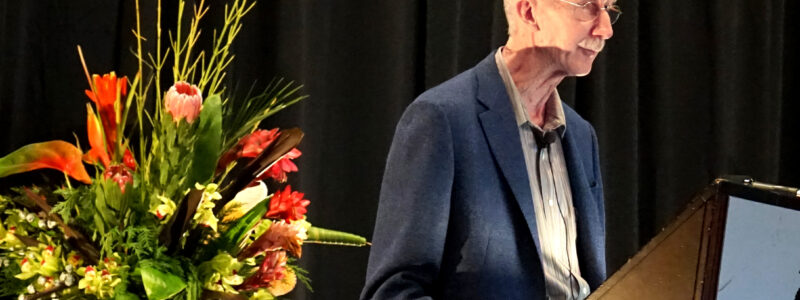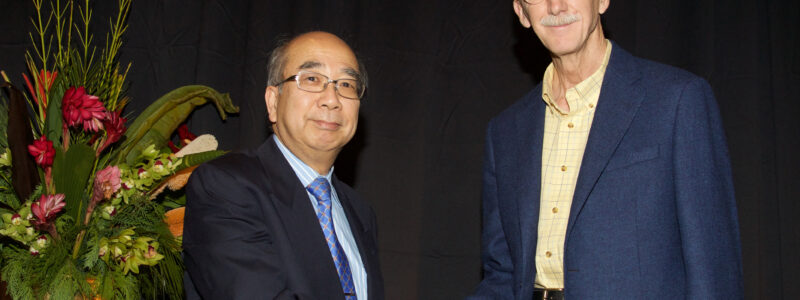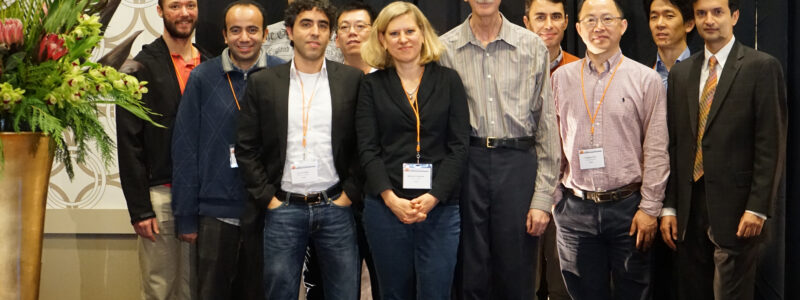December 2014
It is a truth universally acknowledged that humans are in constant search of two things: entertainment, and new ways to avoid death.
The 2014 Bode Lecture delivered both.
Bruce Francis, a professor emeritus in The Edward S. Rogers Sr. Department of Electrical & Computer Engineering, delivered this year’s talk on the topic of the robot rendezvous problem—designing a control system to outfit wheeled rovers with the simplest possible hardware so that they can meet at a common point.
His plenary lecture motivated some 1,100 attendees of the 53rd Conference on Decision and Control, held in Los Angeles, to converge at a single point—namely, the enormous ballroom of a downtown Los Angeles hotel—on Wednesday, December 17, 2014. This was not, strictly speaking, a rendezvous problem, as the destination of the multiple agents was known a priori.
Professor Francis was selected to receive the most recent Hendrik W. Bode Lecture Prize, given annually by the IEEE Control Systems Society “to recognize distinguished contributions to control systems science or engineering.” Professor Francis was recognized for his seminal contributions to robust and H-infinity control, linear control theory, sampled-data control, and distributed robotics.
“You know that one of the criteria for the Bode Lecture is that the awardee has to be a good speaker, and you will soon witness what that means,” Professor Yutaka Yamamoto, past president of the IEEE Control Systems Society, told the attendees, some of whom had boarded flights from Japan, England and Australia, crossing time zones and date lines to hear the Bode Lecture.
“There will be some math, because that’s the nature of the subject and also because that’s what I like to do,” said Professor Francis in his opening. “My goal is simply to be interesting.”
He did not disappoint.
Distributed robotics has been a hot topic in control theory for more than a decade, as researchers puzzle over controlling the behaviour of distributed multi-agent systems such as swarms of drones or schools of autonomous submarines. Fascinating, certainly. But death-defying?
Consider that each year, 1.3 million people worldwide die in car accidents; 33,000 of these deaths occur in the United States. That’s an average of 93 Americans killed in car accidents every day. According to data from the U.S. Department of Transportation and published in The Washington Post, 90 per cent of traffic accidents are caused by human error.
“It would seem that there is only one practical solution,” said Professor Francis. “Replace the driver by a computer—that is, roboticize the car.”
For what are cars on a road if not distributed robots? Each modern car already contains dozens of computers—introducing control algorithms to regulate spacing, velocity, heading and rendezvous would be relatively easy. But first we need to design effective algorithms—and that’s what Professor Francis is working on, with colleagues such as Professors Tim Barfoot and Angela Schoellig of the University of Toronto Institute for Aerospace Studies, and Mireille Broucke and Manfredi Maggiore in ECE.
Control engineers seek to “purify” complex situations, and herein lies the importance of the rendezvous problem: if a control theorist can design a way to make robots group together, perhaps he can then figure out how to make them form a shape—a circle, for example. And if he can make the robots form a circle, perhaps he can design more complex patterns of behaviour. At its core, rendezvous is a prototype problem.
Professor Francis may never have arrived at this Bode Lecture topic if not for several auspicious rendezvous: the first with Professor Barfoot in 1999, when he was still a graduate student working on a research project to make mobile robots form a circle in order to function as an antenna. Then another meeting in 2001, when Professor Steve Morse of Yale University visited the University of Toronto to discuss the related flocking problem. And finally, joining a “who’s who” of roboticists and biologists at a 2003 workshop, which Professor Francis left full of fresh enthusiasm for the field.
In the talk, Professor Francis reviewed techniques for getting simple mathematical models for mobile robots. Then he discussed control algorithms, based on the idea of pursuit, which can be mathematically proved to achieve rendezvous. The algorithms differ depending on the capability of the cameras that are onboard the robots.
“For these theorems, I’m giving you one reference, and it’s the reference I am co-author on, and I get to do that because I am the Bode Lecturer,” Professor Francis joked during his presentation of theorems. The talk was warmly received, and dozens of attendees lined up for photos, handshakes and reminiscences with the speaker.
Though he said delivering the Bode Lecture is the highlight of his career to date, it is just the first of two major recent awards—later this year Professor Francis will receive the 2015 Control Systems Award, the highest honour in the field of control bestowed by the IEEE.
To the control theory community, Bruce Francis no longer needs to prove anything. Now he proves things because that’s what he likes to do.


